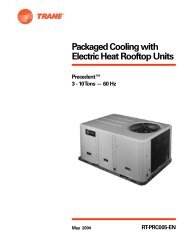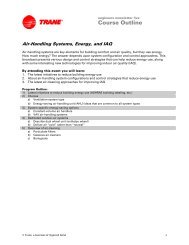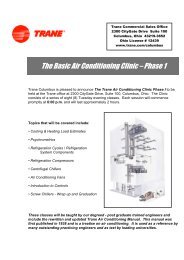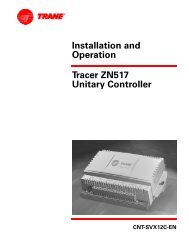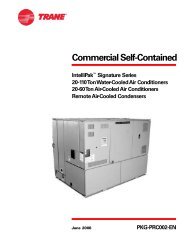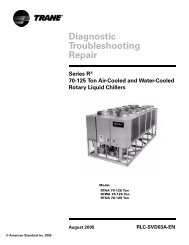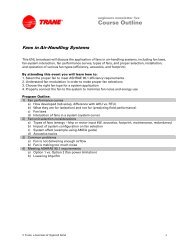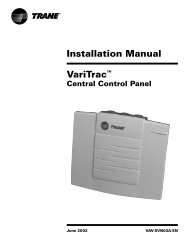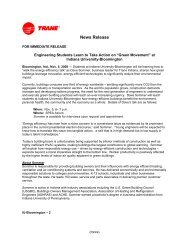Split System Cooling Units - Trane
Split System Cooling Units - Trane
Split System Cooling Units - Trane
You also want an ePaper? Increase the reach of your titles
YUMPU automatically turns print PDFs into web optimized ePapers that Google loves.
Selection<br />
Procedure<br />
<strong>Cooling</strong> Capacity<br />
Step 1 — Calculate the building’s total<br />
and sensible cooling loads at design<br />
conditions. Use the <strong>Trane</strong> calculation<br />
form or any other standard accepted<br />
method.<br />
Step 2 — Size the equipment using<br />
Table PD-1. Match the cooling loads at<br />
design conditions.<br />
Example: The following are the building<br />
cooling requirements:<br />
a. Electrical Characteristics: 460/60/3<br />
b. Summer Design Conditions:<br />
Entering Evaporator Coil:<br />
80° F DB/67° F WB<br />
Outdoor Ambient: 95° F<br />
c. Total <strong>Cooling</strong> Load: 88MBh<br />
d. Sensible <strong>Cooling</strong> Load: 64 MBh<br />
e. Airflow: 3000 cfm<br />
External Static Pressure:<br />
0.77 inches of water gauge<br />
Table PD-1 shows that TWA090A4<br />
with TWE090A has a gross cooling capacity<br />
of 91.1 MBh and 65.9 MBh sensible<br />
capacity at 95° F DB ambient and<br />
3000 cfm with 80° F DB/67° F WB air<br />
entering the evaporator.<br />
To find the net cooling capacities, fan<br />
motor heat must be subtracted. Determine<br />
the total unit static pressure:<br />
External Static: 0.77 in.<br />
Standard Filter: 0.10 in.<br />
Supplementary Electric Heat: 0.23 in.<br />
Total Static Pressure 1.10 in.<br />
Note: The Evaporator Fan Performance<br />
Table has included the effect of<br />
a 1 in. filter already. Therefore, the actual<br />
Total Static Pressure is<br />
1.10 - 0.10 = 1.00 in.<br />
With 3000 cfm and 1.00 inches, Table<br />
PD-19 shows a 1.17 Bhp.<br />
Note: The formula below the table can<br />
be used to calculate Fan Motor Heat:<br />
3.5 X Bhp = MBh<br />
3.5 X 1.17 = 4.09 MBh<br />
Net Total <strong>Cooling</strong> Capacity =<br />
92.0 MBh - 4.10 = 87.90 MBh<br />
Net Sensible <strong>Cooling</strong> Capacity =<br />
65.5 MBh - 4.10 = 61.40 MBh<br />
Heating Capacity<br />
Step 1 — Calculate the building heating<br />
load using the <strong>Trane</strong> calculation<br />
form or any other standard accepted<br />
method.<br />
Step 2 — Size the system heating capacity<br />
to match the calculated building<br />
heating load. The following are building<br />
heating requirements:<br />
a. Total Heating Load: 97.0 MBh<br />
b. 3000 cfm<br />
c. Electric Supplementary Heaters<br />
From Table PD-52, the 34.88 Kw heater<br />
has a capacity of 119,045 Btuh. From<br />
Table ED-5, the 34.88 Kw at 460v indicates<br />
the heater model number is<br />
BAYHTRL435A. This heater will adequately<br />
cover the building’s heating<br />
requirement.<br />
Air Delivery Selection<br />
External static pressure drop through<br />
the air distribution system has been<br />
calculated to be 0.77 inches of water<br />
gauge. From Table PD-51 static pressure<br />
drop through the electric heater is<br />
0.23 inches of water (0.77 + 0.23 = 1.00<br />
in.). Enter Table PD-35 for TWE090A4<br />
at 3000 cfm and 1.00 static pressure.<br />
The standard motor at 821 RPM will<br />
give the desired airflow.<br />
SS-PRC002-EN 9




